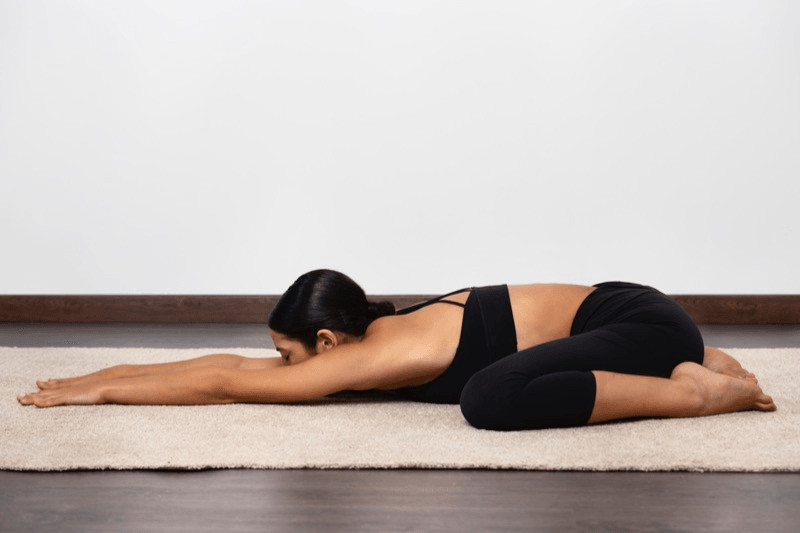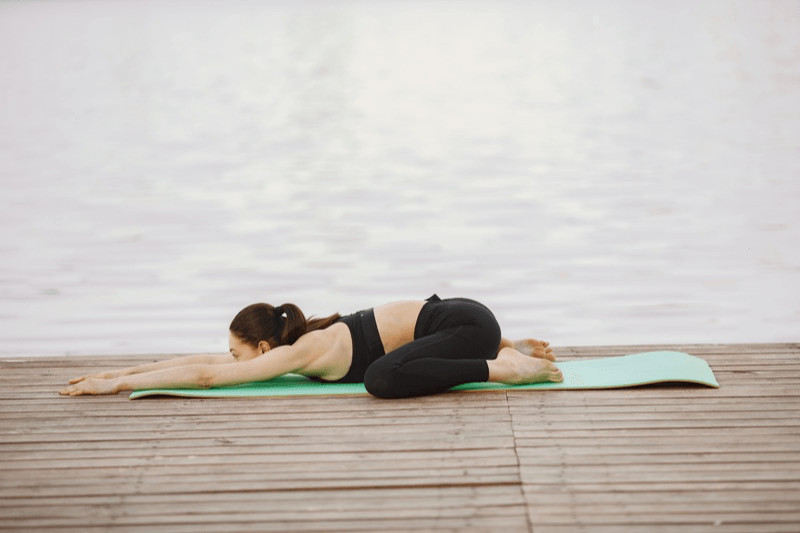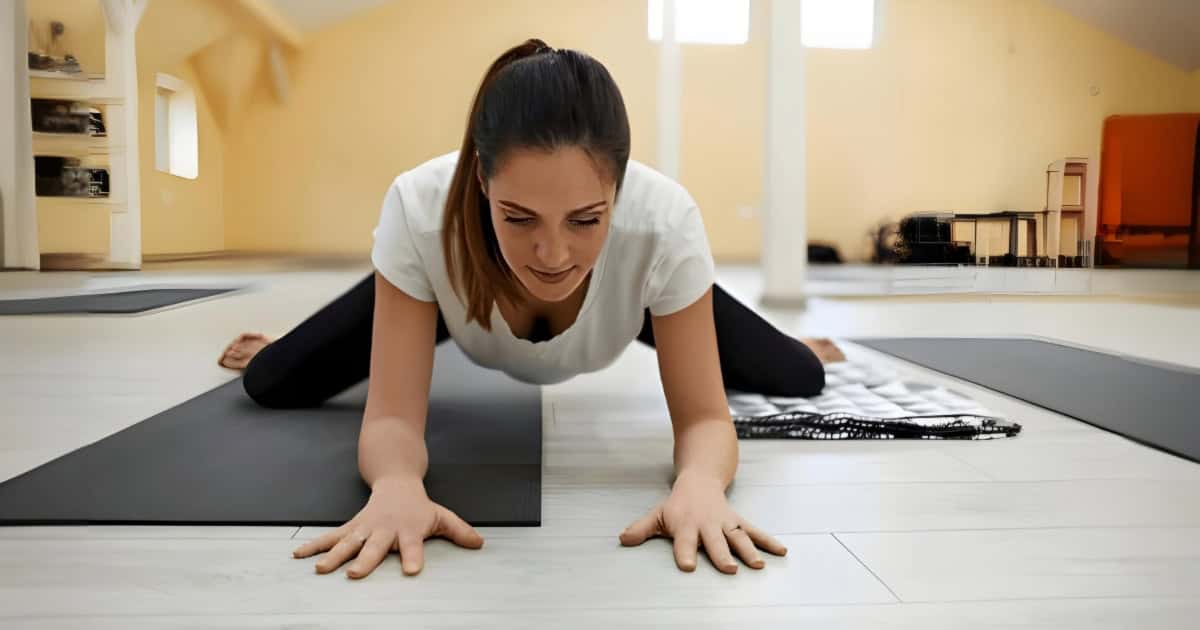Listen to this article:
Key Takeaways
Mandukasana, or Frog Pose, can enhance both physical and emotional health, improving flexibility and digestion and promoting stress relief. To master Frog Pose, follow this step-by-step guide emphasizing proper technique to maximize benefits and minimize the risk of injury.
| MANDUKASANA | |
|---|---|
| Alternate name: | Frog Pose |
| Difficulty level: | Intermediate |
| Pose category: | Hip openers (prone) |
| Muscle groups: | Inner thighs (adductors) Groin Lower back Core Arms (if upper body position requires support) Shoulders (if upper body position requires support) |
| Physical benefits: | Enhances flexibility in the groin area, strengthens abdominal muscles. |
| Therapeutic applications: | Hip mobility, lower back pain relief |
| Preparatory poses: | Cat-Cow Stretch (Marjaryasana-Bitilasana) Lizard Lunge (Utthan Pristhasana) Yogi Squat (Malasana) |
| Counterposes that follow well: | Extended Puppy Pose (Uttana Shishosana) Sphinx Pose (Salamba Bhujangasana) Pigeon Pose (Eka Pada Rajakapotasana) |
| Chakras activated: | Sacral Chakra (Svadhishthana) |
| Most helpful prop: |  Foam block under pubic bone - supports tight hips. See latest price |
Hip openers are a big part of my yoga practice and teaching. In a world where many of us are sedentary, hip-opening stretches have become more crucial than ever, especially for those dealing with lower back pain.
Mandukasana, or Downward Facing Frog Pose, is one absolute gem for hip mobility. This accessible yet powerful pose invites us to connect with our bodies while addressing the needs of our hips and lower back.
I can personally say that Mandukasana is one of my go-to poses after I’ve been sitting at my desk writing for a prolonged time. So, I’m particularly excited to guide you through this asana and share its transformative potential with some expert advice.
Prepare yourself for a journey of exploration and rejuvenation. Hop onto your yoga mat, embrace the present moment, and join me in unraveling the secrets of Mandukasana.
Watch our recommended steps for entering, holding, and exiting the pose.
Contents
- 1 Mandukasana: History, Origin, and Significance
- 2 Understanding Frog Pose in Yoga
- 3 Step-by-Step Guide to Mastering Mandukasana
- 4 Proper Technique and Safety in Frog Pose
- 5 Modifications and Variations of Mandukasana
- 6 Integrating Mandukasana into Your Yoga Practice
- 7 Enhancing Physical Well-being with Mandukasana
- 8 Improving Emotional and Mental Health Through Mandukasana
- 9 Summary
- 10 Frequently Asked Questions
Mandukasana: History, Origin, and Significance
Ancient Roots
Mandukasana, or Frog Pose, has deep roots in yoga history. An upright version of this asana appears in the 17th-century Hatha yoga text, the Gheranda Samhita. The modern adaptation of Mandukasana looks slightly different as a downward-facing pose with the arms reaching forward along the floor.
The pose is named from the Sanskrit words manduka, meaning frog, and asana, meaning posture. When performed, this pose resembles a frog at rest, with legs splayed out behind you.
Yoga Integration
You’ll encounter Mandukasana most often in Yin and Hatha yoga practices. These styles emphasize holding postures for longer periods — sometimes several minutes — to deepen stretches and strengthen muscles.
Understanding Frog Pose in Yoga
Pose Category
Mandukasana is an intermediate-level posture due to the intensity of the stretch. Beginners are welcome to try this pose under the expert guidance of a yoga teacher. This asana falls into the category of hip openers, with the body in a prone (face-down) position.
Muscle Engagement
When you perform Mandukasana, you target several muscle groups:
- The inner thighs (adductors) and groin feel a deep stretch during this exercise.
- Muscles in the lower back and core can lengthen and also engage lightly.
- Depending on your upper body position, your arms and shoulders work to support you in this position.
Step-by-Step Guide to Mastering Mandukasana
Although Mandukasana can be intense, there’s no reason beginners shouldn’t try it! Follow these steps to ease into the final pose.
Begin in Table Top
- Come onto all fours, with your palms underneath your shoulders and hips stacked over your knees.
- Lightly engage your core muscles by pressing your belly in toward your spine.
Move Mindfully into Mandukasana
- Gradually widen your knees until you feel a stretch but no pain in your inner thighs.
- Flex your feet and place the inner edges of your feet on your mat, toes pointing out.
- Carefully lower your hips toward the floor.
- Come down onto your forearms. Reach the top of your head forward, maintaining length in the spine.
- If your flexibility allows, lower your chest and forehead down to the mat and reach your arms forward.
- Hold your Frog Pose for 1 to 3 minutes, breathing deeply.
Exiting the Pose
- To release Mandukasana, press your forearms into your mat to lift your chest and head.
- Place your palms on the floor and lift your torso further.
- Gradually walk your knees back in, returning to Table Top.
Breath Awareness
Breathing plays an essential role in intense poses like Mandukasana. Use your breath intentionally to ease deeper into the stretch. With each exhale, surrender a little more into the stretch. Let gravity do the work of drawing your hips toward the floor, and continue breathing naturally.
Proper Technique and Safety in Frog Pose

To ensure absolute safety in this stretch, review these expert alignment tips:
- Knee Placement: Align your knees with your hips and distribute your weight evenly. Be especially mindful that you feel no pain, pressure, or pulling sensations in your knees. If keeping your knees at a 90-degree angle is uncomfortable, try bringing your big toes together.
- Hip Height: Avoid forcing your hips toward the floor. Opening tight hips takes time, so don’t rush it.
- Core Engagement: Keep your abdominal muscles active to support your spine and prevent your lower back from sagging toward the floor.
- Body Awareness: Listening to your body is essential when practicing any asana. It tells you when something isn’t right to prevent overstretching or injury. A bit of discomfort is natural as this is an intense stretch, but you should never feel sharp pain.
Modifications and Variations of Mandukasana
Using props can offer support and enhance your Mandukasana experience. Especially in Yin practices when you may spend several minutes in the pose, using props will allow you to hold it longer without discomfort. Here are some ideas you can try:
- Bolster: Place a bolster vertically under your body for a restorative and relaxing experience.
- Block: For tight hips, set a foam block horizontally under the pubic bone for extra support.
- Blankets: To keep the knees and ankles comfortable, place folded blankets under the knees and lower legs.
Since the position of Mandukasana can be tough on the knees. I recommend using a thick yoga mat like lululemon’s 6mm workout mat.

lululemon’s Lift and Lengthen Yoga Block
Arm Positions
Arm placement in Mandukasana changes your experience in the pose. Try these options and see which position feels best for your body.
- Bring your elbows underneath your shoulders and press your forearms and palms into the floor, lifting your upper body.
- Fold your arms, stacking your forearms and let your forehead rest on your arms.
- Extend both arms forward, palms and forehead resting on the floor.
Knee Distance
Adjusting knee distance is a simple yet effective way to control intensity in Mandukasana. Bringing the knees closer reduces pressure on the hips; spreading them wider increases the stretch in the inner thighs.
When my students learn this pose for the first time, I advise them to keep their knees reasonably close due to tightness in the hips. Over time and with consistent practice, they can move them further apart comfortably, which deepens the stretch in the hips.
Integrating Mandukasana into Your Yoga Practice
Warm Up

As Mandukasana is a deep stretch, it’s vital you warm up properly. I prefer to mobilize my lower back with a few rounds of Cat and Cow stretch to start, followed by Lizard Lunge to begin opening my hips. Then, Malasana or Yogi Squat provides is the last step before hopping into Frog Pose.
Try a Frog Pose Yoga Sequence
Mandukasana is an excellent addition to any type of yoga sequence. It targets the inner thighs and helps in opening the hips. This pose can be particularly beneficial after practicing yoga postures that require significant leg strength or flexibility.
Some of my favorite ways to use Mundakasana are within a hip-opening sequence or in a Yin yoga practice with other poses that offer a deep stretch to other body areas.
Try building a sequence of your own by combining Mandukasana with these yoga postures:
Extended Puppy Pose
I love using Puppy Pose between rounds of Mandukasana, alternately stretching my upper and lower body.
From Table Top Pose, walk your hands forward and bring your forehead to the floor, keeping your hips stacked over your knees.
Sphinx Pose
Sphinx lengthens your hip flexors and spine, making this a wonderful complement to Mandukasana.
Lie on your belly and bring your elbows underneath your shoulders. Press your forearms and palms into the floor and lift your chest and shoulders. Reach the crown of the head forward, creating length in the spine.
Pigeon Pose
To continue with your hip opening, try Pigeon Pose after Mandukasana.
From Table Top, bring your right knee forward toward your right elbow. Lower your leg to your mat with your right foot behind your left wrist. Pres your hips forward and ease down gently to the floor as you extend your left leg behind you. Hold for 1 to 2 minutes, then repeat Pigeon on your other side.
Exercise Recovery
Mandukasana can be your saving grace after intense leg workouts or another type of exercise like running or cycling. Using this asana as a counterpose helps release tension from the legs, reduces joint stiffness and muscle soreness, and improves overall movement in subsequent sessions.
Enhancing Physical Well-being with Mandukasana
Though its main focus is hip opening, Mandukasana offers many benefits to your whole body.
- Healthy Hips: Mandukasana stretches and strengthens muscles surrounding the hip joint, including the inner thighs and groin. Hip joint stability is crucial for supporting all types of movement.
- Back Pain Relief: If you spend several hours seated at a desk or in a car, you’re likely familiar with how tight hips contribute to lower back pain. Mandukasana helps release tension in these areas to ease stiffness after long periods of sitting.
- Better Posture: Besides relieving mild back pain, this asana can improve your posture as it stretches your spine and back muscles.
- Improved Digestion: The way you fold your body in this yoga position applies gentle pressure on the stomach area, which can help move things along in your digestive tract.
Improving Emotional and Mental Health Through Mandukasana
Aside from the physical perks, Mandukasana brings many benefits to your mind.
- Promotes Deep Breathing: Mandukasana lengthens your torso, allowing you to take deep belly breaths. Incorporating breathing exercises like counting breaths in Mandukasana helps me stay in the pose longer, breathing through discomfort and into release.
- Stress Relief: The deep release of this asana brings your full attention to your present experience. As the body releases physical tension, you’ll feel your mind also become calmer.
- Enhanced Concentration and Resilience: Mandukasana requires a high body awareness and termination. This asana can be intense even for advanced yogis! I’ve found if I focus my mind on my breathing, I can stick with it and end up experiencing a much-needed stretch.
- Emotional Release: According to the philosophy of somatic therapy, our hips are storehouses for emotional tension. As you practice Mandukasana, opening the hips may lead to an unexpected release of emotion.

Summary
Incorporating Mandukasana into your yoga practice is a step toward a more balanced body and mind. Once you practice this pose regularly, the positive changes will be noticeable. The ripple effects of incorporating Frog Pose yoga into your routine extend far beyond the mat, expanding the potential for flexibility, mobility, strength, and inner calm.
As you explore this asana, not only will you witness changes in your physical body, but you may also discover the profound mental and emotional shifts that accompany a dedicated yoga practice. Review the expert tips in this guide to ensure proper technique, minimizing the risk of injury while maximizing this asana’s many benefits.
Trust the process, breathe through the challenges, and experience the magic of Mandukasana for yourself. Your journey to holistic well-being begins with a single leap into the heart of this empowering yoga practice.
Pop quiz! 🧘🤔
Regularly practicing Mandukasana can alleviate back pain.
Breath awareness is an important part of practicing Mandukasana.
Mandukasana is also called Seal Pose
Frequently Asked Questions
What is Mandukasana in yoga?
Mandukasana, also known as Frog Pose, is a yoga posture that helps stretch your legs and hips and can improve flexibility and release body tension.
What are the main benefits of practicing Mandukasana?
Practicing Mandukasana can enhance flexibility in the groin area, strengthen abdominal muscles, and help improve digestion due to the gentle pressure applied to the abdomen.
Can I modify Mandukasana if I’m not very flexible?
Yes, modifications such as placing a cushion under the hips or using blocks beneath your hands can make Mandukasana more accessible while building up flexibility over time.
How often should I integrate Mandukasana into my yoga routine for best results?
Incorporating Mandukasana regularly into your routine can yield better results; however, frequency should be based on individual comfort level and overall yoga sequence structure.







